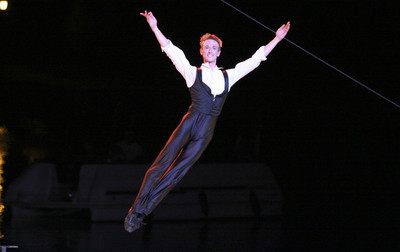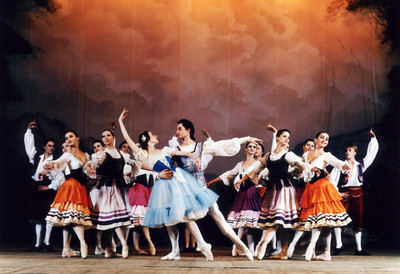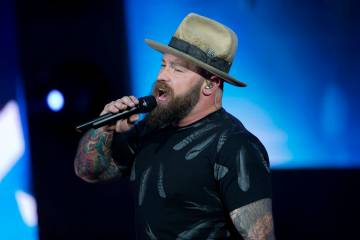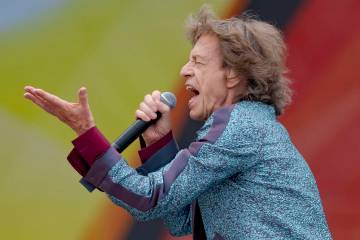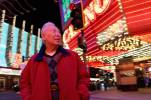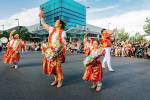Classical Dance Fever
Plié it again, Sam.
That line would've been emblazoned in movie history had Bogie worn a tutu in "Casablanca." (Don't even try to imagine it.) Film fans are forever grateful he didn't.
Others are better suited to ballet couture. To channel that sardonic saloonkeeper with the macho squint: Of all the dance joints in all the world, they hoofed into ours.
"When George Balanchine would choreograph a ballet, he would do it so easily, it poured out of him," says Sandra Jennings, a Balanchine protege and repetiteur -- i.e., a tutor/coach of ballet dancers -- for the "All-Balanchine" program performed by Nevada Ballet Theatre today and Saturday, with a live musical assist from the Las Vegas Philharmonic.
Hosting the classical hoofers is the University of Nevada, Las Vegas, which keeps its leotards on to also welcome the Russian National Ballet to the campus on Wednesday.
"We always look forward to our tour in the USA," says Sergei Radchenko, artistic director of the Russian company.
Tying together the two troupes' traditions is Balanchine, who was born Giorgi Melitonis dze Balanchivadze in 1904 in St. Petersburg, where he perfected his technique before defecting to the West in 1924. (He died in 1983.)
"Because I worked with Balanchine, I think I can bring that direct descendent line into the work," says Jennings, also the repetiteur for the George Balanchine Trust, who danced for the master as a child before he requested she join the New York City Ballet, where she performed principal and soloist roles for nearly a decade. "When I was in the company, he was at a point where he wanted things very jazzy, so I try to give that influence to the dancers."
On the Balanchine bill are his masterworks "Serenade" (1934), his first ballet born in the United States and set to Tchaikovsky's "Serenade for Strings"; "Concerto Barocco" (1941), accompanied by Bach's "Double Violin Concerto in D Minor"; and "Who Cares?" (1970), a Balanchine tribute to Broadway celebrating the music of George Gershwin.
"He was a true genius, and there aren't that many you come across in your life," Jennings says. "His classes were so simple, and yet they made you so much better as a dancer. I worked with Jerome Robbins and it was so hard for him, even though he was a great choreographer, too. It was work with Jerry. But with Mr. B, it felt so natural."
Most natural for Balanchine were pieces such as "Serenade," because they kept him creatively connected to Tchaikovsky, a muse he particularly cherished. "He related Tchaikovsky to something deep in his soul," Jennings says. "In 'Themes and Variations' (his ballet set to the final movement of the composer's "Suite No. 3 for Orchestra in G Major"), they'd get to a certain section, and he would close his eyes and look up at every performance. There was something about that music that moved him in a certain way that he thought it was almost too beautiful to have steps to."
On an Americanized level of musical inspiration, she says, Gershwin got his ballet shoes a-tappin' in, shall we say, fascinating rhythm. " 'Who Cares?' was one of his favorite ballets. It was so American, so jazzy," she says. "He liked a lot of Gershwin. In class, he was able, within two notes of the pianist playing, to know the tune."
Shifting back to ballet of Balanchine's native land, the Russian National Ballet's return engagement brings a fresh presentation. "In Las Vegas, already we have done 'Swan Lake' and 'Sleeping Beauty,' but this time is a program of highlights," says Radchenko, an acclaimed 25-year veteran of the Bolshoi Ballet. "This will be even better for Las Vegas."
The Russian troupe rose out of the Mikhail Gorbachev perestroika era of the late-1980s, when many of the then-Soviet Union's top-tier dancers and choreographers felt freer to flex creative muscle, honoring not only Russian ballet principles and traditions, but beginning to absorb outside influences from around the world, including ours, into their repertoire.
"America has influenced us in technique," Radchenko says, "because you find lots of interesting things in the modern dance that we are adopting, using them in classical ballet."
So this week, a Nevada troupe celebrates a Russian-born icon who adored Gershwin while a Russian dance troupe arrives with a style tinged with American inspiration. Now that's a superpower summit infused with creative glasnost.
Appreciating the dedicated dancers of this week's balletic smorgasbord -- and given his affinity for classic Americana -- Balanchine would surely echo the legendary Bogie:
We'll be lookin' at you, kids.
Contact reporter Steve Bornfeld at sbornfeld@ reviewjournal.com or 702-383-0256.
Preview Nevada Ballet Theatre's "All-Balanchine" program 8 p.m. today, 2 p.m. Saturday Artemus Ham Hall, University of Nevada, Las Vegas, 4505 S. Maryland Parkway $25-$75 (895-2787) Russian National Ballet 8 p.m. Wednesday Artemus Ham Hall, University of Nevada, Las Vegas, 4505 S. Maryland Parkway $45-$90 (895-2787)



